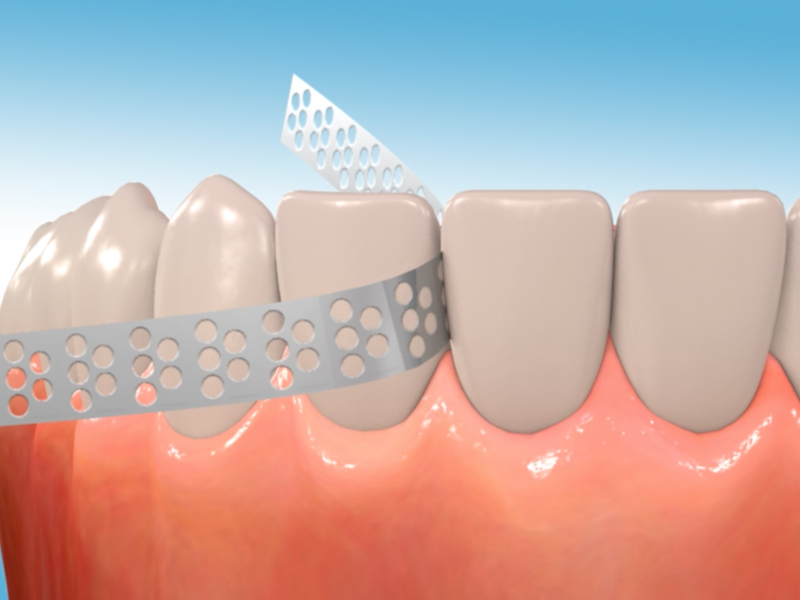<p>Interproximal reduction (IPR) is one of the most common methods to create the required space for crowded dentition treatment with invisible orthodontic appliances.</p> <p><br></p><h4><b>What is interproximal reduction (IPR)?</b></h4> <p>Interproximal reduction (IPR) is the mechanical removal of some of the outer tooth surface, known as enamel, between teeth. It is the process of using diamond dental burs, abrasive discs, hand-held abrasive stripes, etc. to remove a small amount of interproximal enamel to gain the required space for resolving crowded dentition and aligning the patient’s teeth. Some teeth can have their width decreased by up to half a millimeter. The teeth can then be straightened using the extra space left over after interdental reduction.</p><p><br></p> <h4><b>Process of interproximal reduction (IPR)</b></h4> <p>Interproximal reduction (IPR) is performed by hand tools like <b><u><font color="#3984c6"><a href="for-clinic/clinic-kits/1806" target="_blank">diamond dental burs</a></font></u></b>, <b><u><font color="#3984c6"><a href="diamond-disc-laboratory" target="_blank">abrasive discs</a></font></u></b>, hand-held abrasive stripes, etc. The tools can either have a single side or two sides. The diamond dental burs and abrasive discs are attached to a drill and are guided along the contact area by hand. The strips are gently moved backward and forward in a sawing motion until the tooth has been reduced to the proper size. The size can be checked by an IPR gauge that slides in between the teeth to determine the proper space and width. However, there is typically a limit on the amount of IPR that can be performed on a tooth during treatment.</p><p><img src="https://www.burdental.com/image/catalog/Blog/220720-Interproximal-Reduction/1806.png" style="width: 401px;"></p><p> <b><u><font color="#3984c6"><a href="for-clinic/clinic-kits/1806" target="_blank">1806 Interproximal Enamel Reduction (IPR) For Ortho</a></font></u></b></p><p> <font color="#3984c6"><b><u><a href="for-clinic/clinic-kits/1806" target="_blank">https://www.burdental.com/for-clinic/clinic-kits/1806</a></u></b></font><br></p><p><br></p> <h4><b>Advantages of interproximal reduction (IPR)</b></h4> <p>In some cases teeth may have been crowded for a long time or the gum may not have "filled in" between the teeth, resulting in an apparent black region where the teeth and gum meet. They are known as “black triangles”. IPR can help bring the teeth closer together to reduce these “black triangles” - the appearance of extra gaps or spaces between teeth.</p> <p>In addition, nterproximal reduction is frequently utilized in conjunction with orthodontic treatments to help patients move teeth into proper places. When teeth are in proper places, people can better chew and digest the food, keep their teeth cleaner and healthier, and speak more clearly. Crooked teeth can also contribute to jaw misalignment which may result in neck and shoulder pain as well as headaches.</p><p><br></p> <p><b>*Tips: </b></p> <p>The majority of patients are suitable for interproximal reduction (IPR). However, it is often not advised if the patients have poor oral hygiene, small amounts of interproximal enamel or very rectangular teeth.</p> <p>Interproximal reduction (IPR) does not result in the tooth appearing any thinner, nor should it result in an increased risk of tooth decay or sensitivity, because there are only a very small portion of enamel removed.</p><p><img src="https://www.burdental.com/image/catalog/Blog/220720-Interproximal-Reduction/INTERPROXIMAL-REDUCTION -discs.jpg" style="width: 100%;"><br></p>
- Home
-
Products
- Diamond Burs For Clinic
- Tungsten Carbide Burs
- Surgical Tungsten Carbide Burs
- Triming Finishing Gold Tc Bur
- Diamond Stones & Diamond Polishers
- Diamond Rubber Polishers
- Cleaning Burs After Debonding
- Silicon Polishers
- White Stones & Green Stones
- Polishing Burshes
- Mandrels
- Blocks, Sterilisable
- Clinic Kits
- Samples Collection
- Dental Equipment
- Dental Handpiece & Implant Bender
- Dental Mobile Photography
- Diamond Bur Hp
- Fully Sintered Diamond Bur Hp
- Diamond Disc
- Plaster Trimming Wheel
- Cad/cam Milling Burs
- Tungsten Carbide Bur
- Tungsten Carbide Cutter Hp
- Tungsten Carbide Burs For Milling Machines
- Diamond Stones For Zirconia Or All Ceramics
- Diamond Polishers For Zirconia Or All Ceramics
- Silicon Polisher
- Silicon Polishing Burs For Composite Resins
- Mounted Stone
- Mounted Sandpaper
- Polishing Brushes & Felt Bob & Burmandrels
- Polishing Brush & Wheel In Bristle Cotton Cloth
- Felt Bobs & Burs
- Hard Z Cutter
- Sharpening Stones
- Cleaning Brushes By Hand
- Stainless Steel Discs
- Stone Disc
- Technician Kits
- Flexsoft Partial Denture
- Empty Aluminum Cartridge
- About Us
- Blog
- Catalogs
- Contact Us


